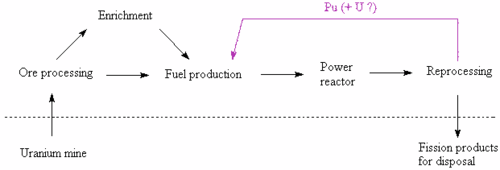Once-through fuel cycle
Not a cycle per se, fuel is used once and then sent to storage without further processing save additional packaging to provide for better isolation from the biosphere. This method is favored by six countries: the United States, Canada, Sweden, Finland, Spain and South Africa.[1]Some countries, notably Sweden and Canada, have designed repositories to permit future recovery of the material should the need arise, while others plan for permanent sequestration in a geological repository like Yucca Mountain in the United States.
Plutonium cycle
Several countries are using the reprocessing services offered by BNFL and COGEMA. Here, the fission products, minor actinides, activation products, and reprocessed uranium are separated from the reactor-grade plutonium, which can then be fabricated into MOX fuel. Because the proportion of the non-fissile even-mass isotopes of plutonium rises with each pass through the cycle, there are currently no plans to reuse plutonium from used MOX fuel for a third pass in a thermal reactor. However, if fast reactors become available, they may be able to burn these, or almost any other actinide isotopes.
Minor actinides recycling
It has been proposed that in addition to the use of plutonium, the minor actinides could be used in a critical power reactor. Tests are already being conducted in which americium is being used as a fuel. [2]
A number of reactor designs, like the Integral Fast Reactor, have been designed for this rather different fuel cycle. In principle, it should be possible to derive energy from the fission of any actinide nucleus. With a careful reactor design, all the actinides in the fuel can be consumed, leaving only lighter elements with short half-lives. Whereas this has been done in prototype plants, no such reactor has ever been operated on a large scale, and the first plants with full actinide recovery are expected to be ready for commercial deployment in 2015 at the earliest.
However, such schemes would most likely require advanced remote reprocessing methods due to the neutron emitting compounds formed. For instance if curium is irradiated withneutrons it will form the very heavy actinides californium and fermium which undergo spontaneous fission. As a result, the neutron emission from a used fuel element which had included curium will be much higher, potentially posing a risk to workers at the back end of the cycle unless all reprocessing is done remotely. This could be seen as a disadvantage, but on the other hand it also makes the nuclear material difficult to steal or divert, making it more resistant to nuclear proliferation
It so happens that the neutron cross-section of many actinides decreases with increasing neutron energy, but the ratio of fission to simple activation (neutron capture) changes in favour of fission as the neutron energy increases. Thus with a sufficiently high neutron energy, it should be possible to destroy even curium without the generation of the transcurium metals. This could be very desirable as it would make it significantly easier to reprocess and handle the actinide fuel.
One promising alternative from this perspective is an accelerator driven subcritical reactor. Here a beam of either protons (United States and European designs)[3][4][5] or electrons(Japanese design)[6] is directed into a target. In the case of protons, very fast neutrons will spall off the target, while in the case of the electrons, very high energy photons will be generated. These high-energy neutrons and photons will then be able to cause the fission of the heavy actinides.
Such reactors compare very well to other neutron sources in terms of neutron energy:
- Thermal 0 to 100 eV
- Epithermal 100 eV to 100 KeV
- Fast (from nuclear fission) 100 KeV to 3 MeV
- DD fusion 2.5 MeV
- DT fusion 14 MeV
- Accelerator driven core 200 MeV (lead driven by 1.6 GeV protons)
- Muon-catalyzed fusion 7 GeV
As an alternative, the curium-244, with a half life of 18 years, could be left to decay into plutonium-240 before being used in fuel in a fast reactor.






No comments:
Post a Comment